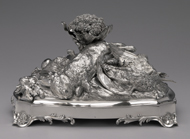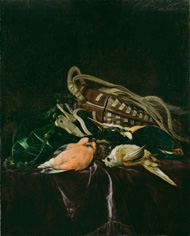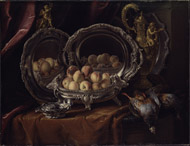|
The Machine d'Argent is a masterpiece of French 18th-century silver made by one of France's foremost goldsmiths, François-Thomas Germain. In 1748 Germain had succeeded his renowned father, Thomas Germain, as sculptor and goldsmith to King Louis XV. François-Thomas took over his father's workshop in the Louvre Palace in Paris, complete with his designs and models, many of which were taken from casts of real vegetables and dead creatures. The assemblage of casts in the Machine d'Argent demonstrates an exceptional originality of concept while striking a perfectly balanced Rococo composition.
This exhibition celebrates this unique still-life sculpture by placing it within the context of artistic production in France at the time, illustrated through paintings, objects, and prints. The term Machine d'Argent literally means "machine of silver." At the time, the French word machine meant "an invention of artistic genius or spirit" and was broadly used to describe a centerpiece on a formal dining table during the course of a meal. The Machine d'Argent includes an assemblage of two game birds, a small rabbit, and vegetables. The high level of naturalism achieved in the sculpture exemplifies the desire of artists during the Enlightenment to replicate—even rival—nature in the diversity of life forms, proportions, and textures.
|
 |
|
Hunting was one of the most prestigious pastimes of the nobility during the 1700s. Both hunting and dining developed into extensive rituals with specialized accoutrements, symbols, and traditions. Germain's Machine d'Argent refers to both pastimes.
The subjects of Germain's Machine d'Argent—game birds, rabbit, and vegetables—derive from the tradition of trophies of the hunt, in which dead game was depicted with hunting accessories. It is a subject matter more typically seen in painting, such as the one shown here, in which van Aelst represented three dead birds, a green velvet hunting bag, and a leather falconry lure.
Like Germain, van Aelst excelled at rendering a wide range of surfaces and textures.
|
 |
 |
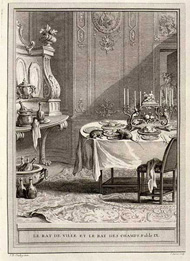
 |
 |
Le rat de ville et le rat des champs (The city rat and the country rat), Jean-Baptiste Oudry and Jean Ouvrier, 1755
|
 |
Germain's Machine d'Argent was made in the manner of elaborate table centerpieces. This print shows how a typical silver centerpiece may have looked on a formal dining table. Such pieces usually included a dish or bowl to hold fruit, arms for candles, and receptacles for condiments.
However, Germain's Machine has no utilitarian function—it is an independent sculpture whose sole purpose was to provide aesthetic delight.
This engraving, from a book of fables, depicts a city rat inviting his country cousin to a sophisticated meal of ortolan, a small European game bird that was a delicacy in the 18th century. The still life in the Machine d'Argent also includes an ortolan along with a long-beaked snipe, a rabbit, and vegetables. This combination specifically represents the ingredients of oille-en-pôt, a rich stew that may have been served as one of the dinner courses.
|
 |

 |
 |
Tureen with Lid and Stand, Thomas Germain, 1729–1731
The Detroit Institute of Arts
|
 |
 |
François-Thomas Germain's father, Thomas Germain was particularly renowned for his naturalistic renderings of flora and fauna and many of his models were taken from casts of dead creatures. François-Thomas inherited and used these models to such effect that it is often difficult to distinguish between the work of father and son.
Tureens were among the most richly decorated and expensive elements of formal dinner services in the 1700s. This is the first known example by Thomas Germain of a tureen decorated with a naturalistically rendered still life. An ortolan is included in the assemblage of fish and vegetables on the lid (the ortolan is on the opposite side of the lid as it is depicted here). The model for the ortolan was used again by Germain's son, François-Thomas, when he created the Machine d'Argent.
|
 |
|
The painter François Desportes was a neighbor of the Germain family in the Louvre in Paris. The frequent visits between Desportes and the Germains resulted in a friendly artistic rivalry illustrated by this painting by Desportes.
The silver tureen with boars'-head handles depicted in the painting is copied from one of Thomas Germain's most famous pieces. Desportes competed with the three-dimensional object by showing three sides of the tureen in his painting—the front and two other angles reflected in the silver platters behind. In turn, both Germains attempted to rival the painter in rendering the subtleties and varied textures of nature in metal.
|
 |
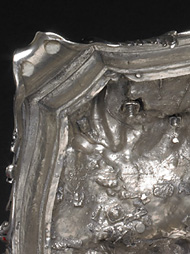
 |
 |
Detail of underside of the Machine d'Argent showing screws that hold the 11 separately cast pieces together
|
 |
 |
|
|
 |
The subject of Germain's Machine d'Argent is closely related to the 18th-century interest in collecting and studying nature. The method by which Germain created it, assembling 11 separately cast animals and vegetables, was a challenge for both hand and mind and demonstrates the sculptor's concern with the techniques for minutely replicating nature.
As such, the work reflects the principles of the Enlightenment, an age of exploration when documenting nature through science and art was a matter of the highest interest, expressing the conviction that nature could be copied, understood, and rivaled.
The exhibition is located at the Getty Center, Museum, North Pavilion
|
 |
